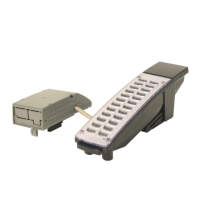Section 2: PCB Installation and Startup
2-6 Section 2: PCB Installation and Startup Aspila EX Hardware Man-
Central Processing Unit (NTCPU) PCB (Figure 2-3)
The NTCPU controls all the functions and operations of the Aspila EX system using the system soft-
ware loaded into the NTCPU memory. One 32-bit NTCPU PCB must be installed in the CPU slot in
the Main Cabinet.
The NTCPU provides:
• 200 trunk ports maximum
• 256 extension ports maximum (System phones and Single line phones)
• 512 extensions maximum including IP Phones and DECT handsets
• 256 virtual extensions
Note that limitations on the maximum ports available depend on the
The NTCPU provides the following:
• Five diagnostic LEDs which indicate the status of various system functions
During normal operation, the “RUN” LED will be flashing and the remaining LEDs will
be off.
• 1019x1019 Time Division Multiplex Switch (TDM Switch)
• Digital Phase Locked Loop (DPLL)
• Tone Generator
• DTMF Tone Sender/Receiver; 32 Channels
• System Tone Sender
• DTMF Tone Sender
• Call Progress Tone Detector
• Conference; 64 Channels
• Caller ID Receiver/Sender; 64 Channels
• A reset switch (RES) which can be used to reset the system
• A load switch (LOAD) which is used for initial system startup or when upgrading system soft-
ware
• One Serial Port
• One USB Port
• One Ethernet Port (10 Base-T/100 Base-TX)
• One PCMCIA Slot
• One EXIFU Interface Connector
• Two Audio Input Terminals (EXMOH & BGM)
• One Audio Output Terminal (External Page)
• One Night Mode Terminal for External Switch
• One Music On Hold External Source
• HDLC Packet Processing
• Real Time Clock (tolerance 30 seconds/month)
• Internal MOH Generation
• One Connector for DSPDBU Daughter Board
• One Connector for PAL EPROM
• One lithium battery (Sony CR2032 or equivalent) which provides battery back-up of system data
and RAM memory for approximately 30 months

